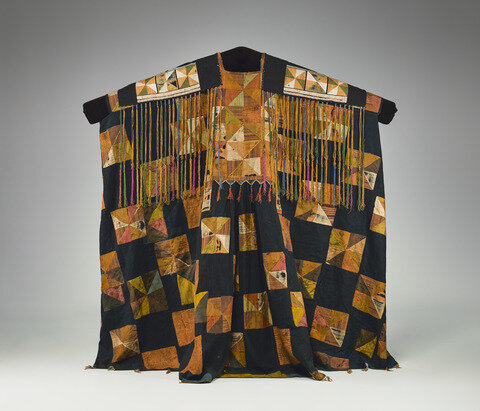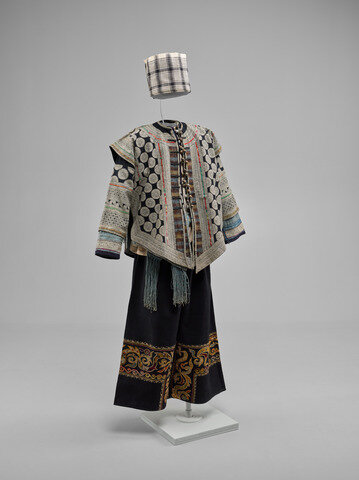September 6, 2019–January 5, 2020
The Yale University Art Gallery presents its first exhibition devoted to garments and accessories from southwestern China, drawn from the museum’s collection
Drawn from a recent gift to the Yale University Art Gallery, Ceremonial Dress from Southwest China: The Ann B. Goodman Collection showcases the visual imagination, artistic skill, and technical knowledge on display in the ceremonial clothing of communities living in Guizhou, Hunan, Sichuan, Yunnan, and other provinces of southwestern China. While the Han people currently make up more than 90 percent of the inhabitants in China, 55 other ethnic and cultural groups, distinguished by lifestyle and language, also live in the country today. The garments and accessories on view were created by and for some of these peoples—including the Dong, Miao, Yao, Yi, and Zhuang—all of whom choose textile as their primary artistic medium, a preference they share with many other cultures in Southeast Asia.
Worn during life-cycle ceremonies such as births, marriages, and deaths, as well as at harvest celebrations and other cultural or historical events, the articles of clothing were constructed by the women of each community. They gathered the cotton and indigo, dyed the cloth, and sewed the jackets, skirts, baby carriers, hats, and shoes on view, embellishing them with appliqué, batik, embroidery, and other techniques. In addition to more than 15 complete ensembles made by women during the 19th and 20th centuries, the exhibition also features silver accessories, such as headdress ornaments, necklaces, and bracelets, that were produced by men and worn as symbols of skill and wealth during seminal moments in the lives of individuals and their communities. While these artists were often charged with representing the traditional designs of their cultural group, they blended such long-standing motifs with their own personal vision and taste to create each piece, resulting in unique, wearable works of art.
This exhibition is the product of an extensive collaboration between the Gallery’s Conservation and Exhibitions Departments, in line with the vision of its two curators—Ruth Barnes, the Thomas Jaffe Curator of Indo-Pacific Art, and Denise Patry Leidy, the Ruth and Bruce Dayton Curator of Asian Art. Barnes and Leidy wanted to display the ensembles to their full effect, with lifelike armatures but without the distraction of mannequins. Mary Wilcop, Postgraduate Associate in Objects Conservation, and Alicia Van Campen, Museum Technician, brought the curators’ idea to life with sculpted archival foam armatures that mimic a body, reflecting how the ensembles were actually worn. “We are delighted with the intimate and engaging display that our colleagues have helped to create,” state Barnes and Leidy. “The installation not only brings the pieces to life, but also allows visitors to look very closely at each piece of clothing and overall ensemble to understand and enjoy the time and skill required to make each work.”
Indigo-dyed cotton is featured in many of the elaborate garments in the exhibition, and the Gallery is delighted to welcome Dr. Jenny Balfour-Paul, a renowned expert on indigo, the “king of dyes,” for an opening lecture titled “Indigo and the Orient: A Story of Blues,” on Thursday, September 26, 2019, at 5:30 pm. More information on all exhibition-related programs can be found on the Gallery’s web calendar at artgallery.yale.edu/calendar.
On View
September 6, 2019–January 5, 2020
Exhibition Credits
Exhibition made possible by the Wolfe Family Exhibition and Publication Fund. Organized by Denise Patry Leidy, the Ruth and Bruce Dayton Curator of Asian Art, and Ruth Barnes, the Thomas Jaffe Curator of Indo-Pacific Art.
Related Programs
Opening Lecture
Thursday, September 26, 2019, 5:30 pm
“Indigo and the Orient: A Story of Blues”
Jenny Balfour-Paul
Gallery Talks
Wednesday, October 2, 2019, 12:30 pm
“Ceremonial Dress from Southwest China: The Ann B. Goodman Collection”
Ruth Barnes and Denise Patry Leidy
Wednesday, November 6, 2019, 12:30 pm
“Behind the Scenes: Preparing Textiles and Objects for Ceremonial Dress from Southwest China: The Ann B. Goodman Collection”
Alicia Van Campen and Mary Wilcop


